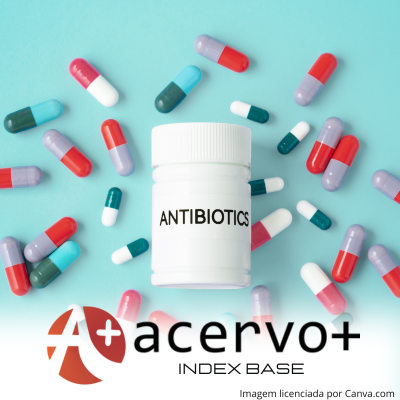Rastreamento de genes de resistência a antibióticos no meio ambiente durante a pandemia da COVID-19
##plugins.themes.bootstrap3.article.main##
Resumo
Objetivo: Identificar os genes de resistência bacteriana, as bactérias resistentes e os antibióticos presentes em diversos meios ambientes em amostra de águas, estações de tratamento e efluentes com e sem ação antrópica, durante o surto pandêmico da COVID-19. Métodos: Trata-se de uma revisão integrativa da literatura que selecionou ensaios clínicos e estudos observacionais em inglês, publicados entre 2020 e 2023, utilizando as bases de dados MedLine e Embase. A busca foi feita utilizando descritores do Medical Subject Headings (MeSH) e Descritores em Ciências da Saúde (DeCS), com foco em genes de resistência a antibióticos, resistência microbiana, COVID-19 e metagenômica. Resultados: Os seis artigos selecionados mostraram variados genes de resistência bacteriana, bactérias resistentes e presença de antibióticos em diversos ambientes com expressivo aumento de muitos deles no período pandêmico. Considerações finais: Nesta revisão evidenciou-se que, de forma massiva, a pressão seletiva exercida pelo uso intenso de antibióticos, durante o surto pandêmico, contribuiu para o aumento da resistência microbiana ou resistomas.
##plugins.themes.bootstrap3.article.details##
Copyright © | Todos os direitos reservados.
A revista detém os direitos autorais exclusivos de publicação deste artigo nos termos da lei 9610/98.
Reprodução parcial
É livre o uso de partes do texto, figuras e questionário do artigo, sendo obrigatória a citação dos autores e revista.
Reprodução total
É expressamente proibida, devendo ser autorizada pela revista.
Referências
2. AARESTRUP FM, et al. Pandemics- One Health preparedness for the next. Lancet Reg Health Eur, 2021; 9: 100210.
3. BAI H, et al. Airborne antibiotic resistome and human health risk in railway stations during COVID-19 pandemic. Environment International, 2023; 172: 107784.
4. BEDFORD J, et al. A new twenty-first century science for effective epidemic response. Nature, 2019; 575 (7781): 130-136.
5. BOMBAYWALA S e DAFALE NA. Mapping the spread and mobility of antibiotic resistance in wastewater due to COVID-19 surge. Environ Sci Pollut Res Int, 2023; 30(58): 121734-121747.
6. BRUMFIELD KD, et al. Microbiome Analysis for Wastewater Surveillance during COVID-19. mBio. 2022; 30; 13(4): 59122.
7. CHENG J, et al. Enrichment of antibiotic resistant genes and pathogens in face masks from coastal environments. J Hazard Mater, 2023; 449: 131038.
8. CHIU CY e MILLER SA. Clinical metagenomics. Nat Rev Genet, 2019; 20(6): 341-355.
9. FURLAN JPR, et al. Genetic plurality of bla(KPC-2)-harboring plasmids in high-risk clones of Klebsiella pneumoniae of environmental origin. Sci Total Environ, 2023; 881: 163322.
10. HARRINGTON A, et al. Urban monitoring of antimicrobial resistance during a COVID-19 surge through wastewater surveillance. Science of The Total Environment, 2022; 853: 158577.
11. HENDRIKSEN RS, et al. Global monitoring of antimicrobial resistance based on metagenomics analyses of urban sewage. Nat Commun, 2019; 10(1): 1124.
12. KANG Y, et al. Alterations of fecal antibiotic resistome in COVID-19 patients after empirical antibiotic exposure. International journal of hygiene and environmental health, 2022; 240: 113882.
13. KHADSE SN, et al. Impact of Antimicrobial Stewardship on Reducing Antimicrobial Resistance. Cureus. 2023; 15(12): 49935.
14. KO KKK, et al. Metagenomics-enabled microbial surveillance. Nat Microbiol. 2022; 7(4): 486-96.
15. KOLOKOTSA A, et al. Effects of tourist flows on antibiotic resistance in wastewater of a Greek island. J Appl Microbiol. 2021; 130(2): 516-527.
16. LEMA NK, et al. Recent Advances in Metagenomic Approaches, Applications, and Challenge. Curr Microbiol, 2023; 80(11): 347.
17. LENART-BOROŃ AM, et al. COVID-19 lockdown shows how much natural mountain regions are affected by heavy tourism. Science of the Total Environment, 2022; 806: 151375.
18. LI J, et al. Etiology and antimicrobial resistance of secondary bacterial infections in patients hospitalized with COVID-19 in Wuhan, China: a retrospective analysis. Antimicrobial Resistance & Infection Control, 2020; 9(1): 153.
19. LIU YJ, et al. Antibiotic resistomes in face-mask biofilm along an urban river: Multiple drivers and co-occurrence with human opportunistic pathogens. Journal of Hazardous Materials, 2023; 455: 131587.
20. MORALES-LEÓN F, et al. Molecular Characterization of the Convergent Carbapenem-Resistant and Hypervirulent Klebsiella pneumoniae Strain K1-ST23, Collected in Chile during the COVID-19 Pandemic. MicrobiolSpectr. 2023; 11(3): 54023.
21. RAFRAF ID, et al. Abundance of antibiotic resistance genes in five municipal wastewater treatment plants in the Monastir Governorate, Tunisia. Environ Pollut, 2016; 219: 353-358.
22. SPÄNIG S, et al. A multi-omics study on quantifying antimicrobial resistance in European freshwater lakes. Environ Int. 2021; 157: 106821.
23. STEENBEEK R, et al. Monitoring the exposure and emissions of antibiotic resistance: Co-occurrence of antibiotics and resistance genes in wastewater treatment plants. Journal of Water and Health, 2022; 20(8): 1157-1170.
24. WANG C, et al. Investigation of Antibiotic Resistome in Hospital Wastewater during the COVID-19 Pandemic: Is the Initial Phase of the Pandemic Contributing to Antimicrobial Resistance? Environmental Science & Technology, 2022; 56(21): 15007-15018.
25. XU Y, et al. Occurrence and distribution of antibiotics, antibiotic resistance genes in the urban rivers in Beijing, China. Environmental Pollution, 2016; 213: 833-840.
26. YADAV S e KAPLEY A. Antibiotic resistance: Global health crisis and metagenomics. Biotechnol Rep (Amst), 2021; 29: 604.
27. ZHAO L, et al. Impact of COVID-19 pandemic on profiles of antibiotic-resistant genes and bacteria in hospital wastewater. Environmental Pollution, 2023; 334: 122133.

